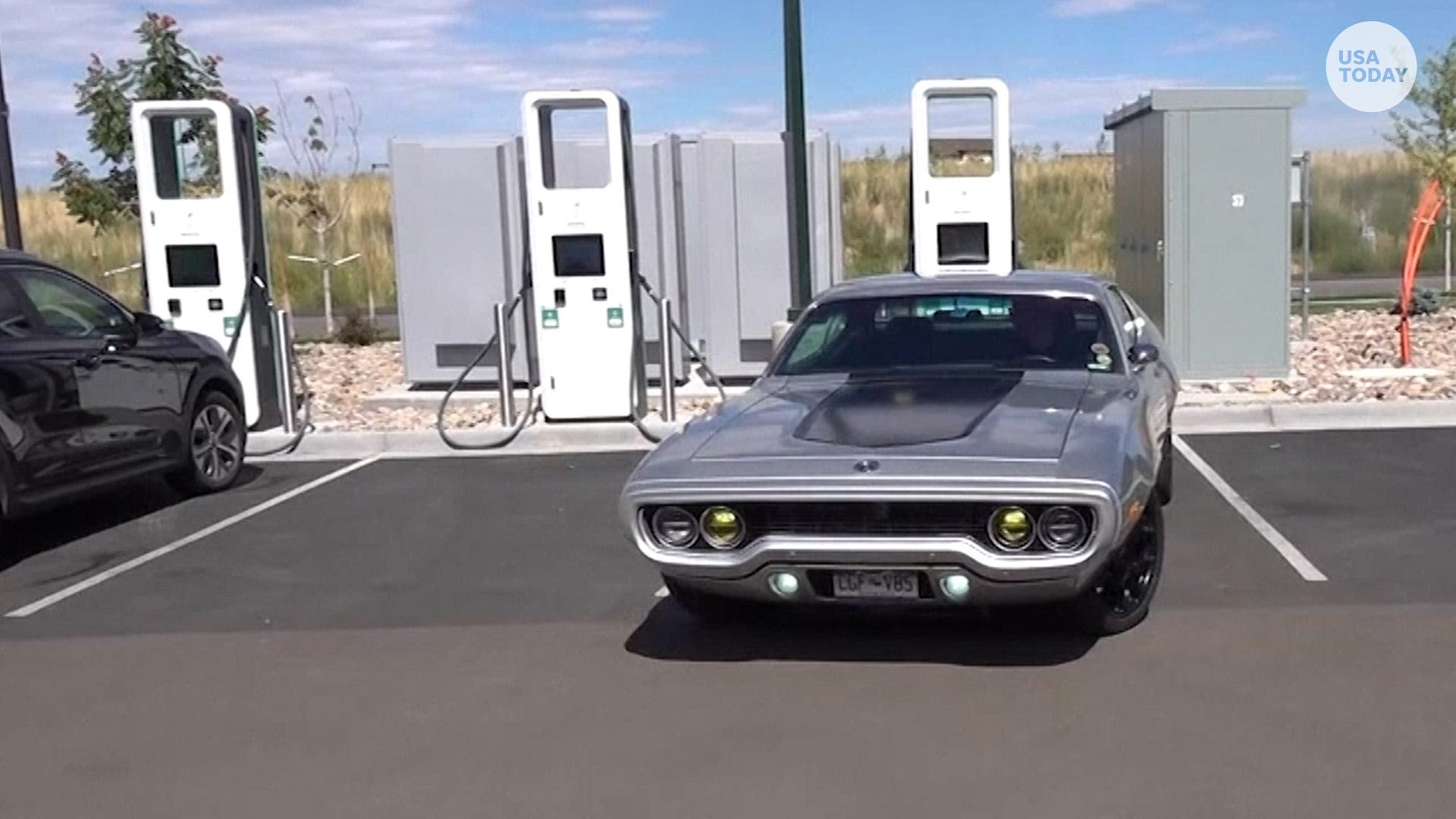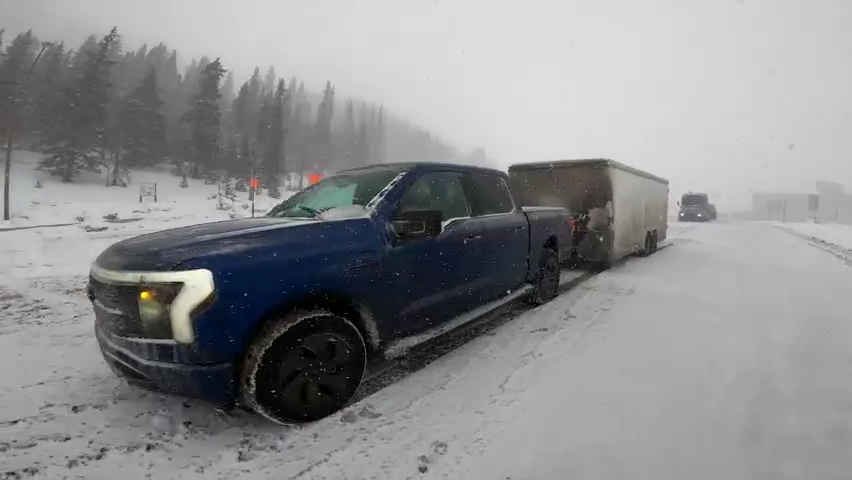
Classic Mustang, Plymouth Satellite and more get electric upgrade
A group of car enthusiasts and tinkerers are turning old sports cars and muscle cars into electric vehicles.
Cody Godwin, USA TODAY

Ford F-150 Lightning towing testing
Ford engineers took the all-electric 2022 F-150 Lightning to Arizona and Colorado for torture testing and endurance.
Provided by Ford Motor Co., Detroit Free Press
Can the growing number of new electric vehicles coexist with dangerous winter weather?
Based on my experience driving a Ford F-150 Lighting electric pickup in the depths of the Christmas weekend bomb cyclone — blowing snow, single-digit temps, high wind and frostbite-inducing feels-like temps far below zero — the answer is yes.
Some of the EV pickup’s characteristics were outstanding. Others require extra thought from the driver, or leave room for improvement.
Things to know:
- The 2023 all-wheel-drive F-150 Lightning crew cab I drove faced a disadvantage most EV owners won’t have: I don’t have a 240-volt charger at my house yet. That increased the pickup’s energy consumption because I couldn’t use household current to warm its battery and cabin to their most comfortable and efficient temperatures before I started driving on battery power. That’s called “preconditioning” and it significantly reduces cold weather’s effect on driving range.
- The storm that hit metro Detroit was dangerous, but not nearly as bad as the deadly one that devastated other parts of the country with several feet of snow.
- Metro Detroit roads were impeded by wind, cold, snow and ice, but they were open. The region was not under a “stay-home” order.
- Just in case, I dressed for prolonged exposure: multiple layers, gloves, knit hat, insulated boots.
Truck wars electrified: Many GM Silverado EV, Ford Lightning buyers just want to be first
Warm and cozy
I drove from my house in Oakland County, Michigan, to Dearborn for dinner with college friends who were in town for the holidays. The temperature was 3 degrees and the instrument cluster said I had 220 miles of range as I left home at 5:30 p.m. The round trip was about 35 miles, mostly surface streets, some highway.
Snow fell steadily, whipped around by winds topping 40 mph. Accumulations made surface streets extremely slippery.
The roads were relatively full, but well short of a typical Friday rush hour. It started slowly from traffic lights, accelerating to 35-40 mph on surface streets, with occasional slowdowns for nervous drivers and people whose tires were no match for the conditions.
I initially used the F-150’s seat and steering wheel heaters rather than its forced-air climate control. Warming occupants through contact with the seat and steering wheel is a more efficient use of electricity than heating all the air in the cabin. I was comfortable, but had to repeatedly engage the air-powered front defroster to clear the windshield and side windows. The electric rear defroster kept that window clear the whole time.
I was warm for the whole drive. I turned the heated driver’s seat off halfway to dinner.
Some EVs — all Teslas, the Cadillac Lyriq, GMC Hummer and some Mercedes — use heat pumps to warm the cabin. The F-150 is more like a space heater on wheels, using electrical resistance to heat air. That takes more energy than a heat pump, making the Lightning’s heated seats/steering wheel a key to winter driving range.
Vehicle of the year:Honors prove the tide has irrevocably turned to EVs
Considering an electric vehicle?4 things to know before you buy
Handling and acceleration
The F-150 Lightning has a big, heavy lithium ion battery under the cab’s floor. Two electric motors provide all-wheel drive — one on the front axle, one on the rear. That layout, which is common among EVs, has benefits for traction and handling.
Batteries are heavy. The F-150 Lightning weighs about 6,000 pounds, more than 1,000 pounds heavier than the heaviest gasoline-powered conventional F-150.
Weight is seldom a vehicle’s friend, but it can help when you need traction. The Lightning’s battery puts the pickup’s center of gravity close to the ground, which helps handling, and right over the wheels, making them less likely to slip.
The electric motors’ very precisely controlled delivery of power to each wheel virtually eliminates wheel spin. I know because I spent an hour watching vehicles around me slip and fishtail while the Lightning hewed to the line I wanted to steer. I could occasionally feel little shifts as the motors modified how much power each wheel got, but the vehicle never strayed.
The extra weight and precise power control were equally welcome on the highway, where traffic moved at a steady 45-50 mph.
What about range?
The Lightning sat for 24 hours before my drive to dinner. Ambient temperature feel from 40 degrees to just above zero, putting a deep chill in the battery. If it’d been connected to a 240V charger with household current, I could’ve used that to warm the battery to around 65 degrees, where it’s most efficient. The cab would also warm to my preferred temperature. Preconditioning is the EV equivalent to remote start for conventional vehicles, except that it makes the vehicle more efficient in addition to warming or cooling the cabin before you get in.
The inability to precondition could have reduced my energy consumption as much as 20% on the initial drive to dinner, according to estimates by engineers who are working to maximize EV efficiency.
I parked the Lightning in my friends’ windswept driveway. It sat for 6½ hours as we shared stories and winter’s night comfort food.
The ambient temperature had fallen to 1 degree when I headed home. I activated the Lightning’s “one-pedal” driving mode, which maximizes battery regeneration when slowing down. I use one-pedal driving almost exclusively in EVs that offer it. I like its efficiency, and the best systems allow you to feather the accelerator for handling and vehicle control.
At the end of the 35-mile round trip, the readout said I had 143 miles range, remaining.
I used a bit more than twice the energy projected for the distance I’d driven, but I never had any concern about getting to my destination or back home safely, in conditions that were about as hostile to EVs as possible, and worse than an owner could expect if they preconditioned for a few minutes before setting out.
It’s also worth remembering that conventional vehicles are also less fuel-efficient in extreme cold. They rely on lubricants that are thick and sluggish until the engines and transmissions warm up. The internal combustion vehicles’ fuel gauges and range estimates don’t reflect that.
I had no difficulties charging the Lightning during the rest of the frigid weekend. The commercial DC fast chargers I used while shopping ran slower than usual, but I had no concerns.
Other questions
People ask me lots of questions about EVs.
That makes sense. EVs are fundamentally different from the internal combustion-powered vehicles we’re accustomed to. Drivers who use EVs regularly develop different habits from those who rely on gasoline, like plugging in every night so they start each day with a full charge.
In addition to the questions, there are widespread misconceptions, but also outright lies from people hostile to the technology.
As the storm raged and temperatures fell, I received emails and social media posts insisting EVs will never work in cold weather, stranding drivers and exposing them to deadly cold.
But, tragically, people have died stranded in gasoline cars, and a fully charged EV can keep its occupants warm for about long as a vehicle powered by a gasoline engine.
Other critics said EVs aren’t reliable because they can’t be charged when storms knock out electricity. But gas pumps don’t work without electricity, either.
EVs have a long way to go, and the U.S. desperately needs more high-powered charging stations, particularly on intercity routes.
But the inevitability of winter storms is not a reason to avoid EVs.
If you don’t believe me, ask Norway, where they know a thing or two about winter and EVs and plug-in hybrids account for more than half of new-vehicle sales.
Contact Mark Phelan: 313-222-6731 or mmphelan@freepress.com. Follow him on Twitter @mark_phelan. Read more on autos and sign up for our autos newsletter. Become a subscriber.
